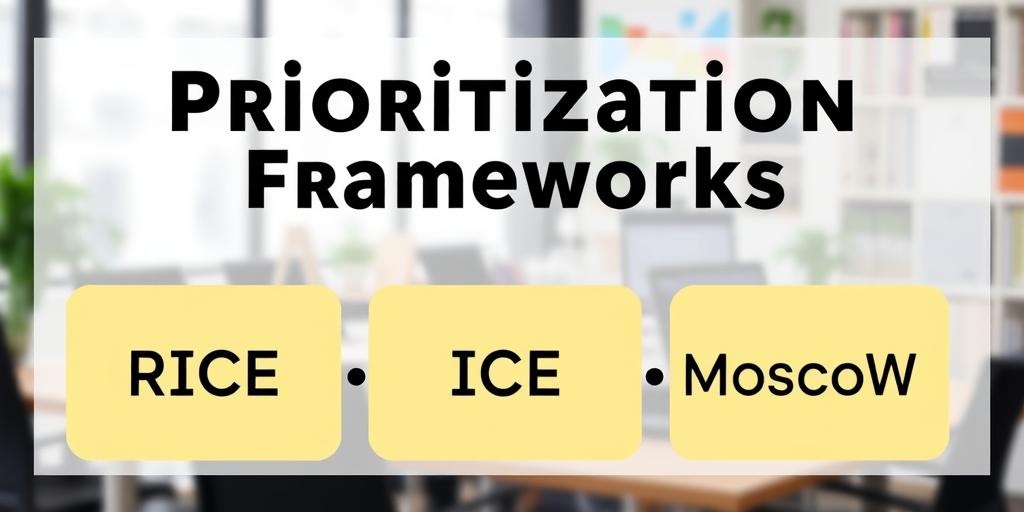Choosing the Right Prioritization Framework: RICE, ICE, and MoSCoW
In project management and product development, prioritization frameworks are essential tools for deciding what to work on first. With so many options available, selecting the right framework can be challenging. This post will explore three popular frameworks: RICE, ICE, and MoSCoW, providing a detailed comparison to help you determine which one best suits your needs.
What are Prioritization Frameworks?
Prioritization frameworks are structured approaches used to evaluate and rank potential projects, features, or tasks. These frameworks provide a clear and consistent method for decision-making, ensuring that the most impactful and urgent items are addressed first.
RICE Prioritization Framework
The RICE framework is a data-driven approach that evaluates projects based on four factors: Reach, Impact, Confidence, and Effort.
- Reach: How many people will this project affect within a specific time frame?
- Impact: What is the extent of the effect on each person?
- Confidence: How confident are you in your reach and impact scores?
- Effort: How many person-months will this project take?
How to Calculate the RICE Score
The RICE score is calculated using the formula:
RICE Score = (Reach x Impact x Confidence) / Effort
Pros of the RICE Framework
- Data-Driven Decisions: RICE relies on quantitative data, reducing bias.
- Comprehensive Evaluation: Considers multiple factors, providing a holistic view.
- Transparency: The scoring process is transparent and easy to understand.
Cons of the RICE Framework
- Data Dependency: Requires accurate data, which may not always be available.
- Subjectivity: Impact and confidence scores can still be subjective.
- Complexity: May be too complex for small projects or teams.
ICE Prioritization Framework
The ICE framework is a simplified version of RICE, focusing on three factors: Impact, Confidence, and Ease.
- Impact: How much will this project positively affect the key metric?
- Confidence: How confident are you that this project will have the predicted impact?
- Ease: How easy is this project to implement?
How to Calculate the ICE Score
The ICE score is calculated using the formula:
ICE Score = (Impact x Confidence x Ease)
Pros of the ICE Framework
- Simplicity: Easy to understand and implement.
- Speed: Quick to score and prioritize projects.
- Flexibility: Suitable for projects with limited data.
Cons of the ICE Framework
- Subjectivity: Relies heavily on subjective scoring.
- Lack of Depth: Does not consider reach, which can be crucial for certain projects.
- Potential Bias: Susceptible to personal biases due to its subjective nature.
MoSCoW Prioritization Framework
The MoSCoW framework categorizes requirements into four groups:
- Must have: Critical requirements that must be included in the final product.
- Should have: Important requirements that should be included if possible.
- Could have: Desirable but not necessary requirements.
- Won't have: Requirements that will not be included in this iteration.
Pros of the MoSCoW Framework
- Simplicity: Easy to understand and use.
- Stakeholder Alignment: Facilitates clear communication and agreement among stakeholders.
- Flexibility: Adaptable to various project types and sizes.
Cons of the MoSCoW Framework
- Subjectivity: Relies on subjective categorization.
- Lack of Granularity: Does not provide a detailed scoring system.
- Potential for Conflict: Stakeholders may disagree on requirement categories.
Choosing the Right Framework
When selecting a prioritization framework, consider the following factors:
- Project Size and Complexity: RICE is suitable for larger projects with available data, while ICE and MoSCoW are better for smaller, simpler projects.
- Data Availability: If you have reliable data, RICE can provide a more data-driven approach. If data is limited, ICE or MoSCoW may be more practical.
- Stakeholder Involvement: MoSCoW is excellent for aligning stakeholders and ensuring everyone understands the priorities.
- Company Culture: Choose a framework that aligns with your company's culture and decision-making processes.
Conclusion
Selecting the right prioritization framework is crucial for effective project management and product development. RICE, ICE, and MoSCoW each offer unique benefits and are suited to different scenarios. By understanding the strengths and weaknesses of each framework, you can make an informed decision that aligns with your project goals and organizational needs.









